Thimphu travel - Bhutan, Asia
Thimphu, the capital and largest city of Bhutan, sits in the scenic Thimphu Valley at an altitude of 2,248 to 2,648 meters (7,375 to 8,688 feet), making it one of the world's highest capital cities. Located just 52 kilometers (32 miles) from Paro International Airport, it serves as the country’s political, economic, and cultural hub.
Thimphu has grown significantly, reflecting its importance as Bhutan’s center of governance, home to the National Assembly and the King’s residence, Dechencholing Palace. The city is rich in cultural heritage, with traditional Bhutanese architecture, ancient monasteries, and iconic landmarks like Tashichho Dzong, which hosts the annual Tshechu festival showcasing vibrant dances and rituals.
Despite its modern amenities like wide roads, hotels, and restaurants, Thimphu is deeply committed to preserving its cultural and ecological integrity through sustainable urban development. Its blend of tradition, modernity, and stunning natural beauty makes Thimphu an attractive destination for visitors eager to experience Bhutan’s unique charm.
Population: Approximately 120,000 in 2024.
Economy: Thimphu is a focal point for Bhutan's approach to "high value, low impact" tourism, which seeks to preserve its cultural heritage and natural environment. The city offers guided tours that emphasize sustainable practices, providing insights into Bhutan's efforts to balance modernization with conservation.
Landmarks: Tashichho Dzong, Buddha Dordenma, National Memorial Chorten, Folk Heritage Museum, Takin Preserve
Bhutan
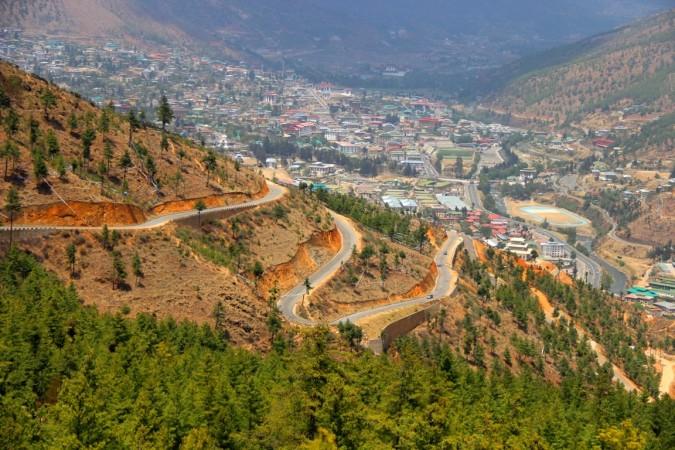
Overview of Thimphu
History & Cultural Influence
Historically, Thimphu became the capital of Bhutan in 1955, replacing the ancient capital of Punakha. This shift was part of a larger modernization effort under the reign of the third king, Jigme Dorji Wangchuck. Thimphu’s establishment as the capital marked Bhutan's transition towards modernization while still retaining its deep-rooted traditions. The city's structure and governance underwent significant changes with the introduction of the Thimphu Structure Plan in 2002, aimed at guiding its development while protecting its ecological and cultural integrity.
Thimphu reflects Bhutan’s unique approach to modernity, infused with traditional values. It is the heart of the nation’s political, economic, and religious life. The city is home to the Tashichho Dzong, a fortress that houses the Bhutanese government and serves as the religious, military, administrative, and social centers of the district.
Interaction with The Locals
Thimphu locals are generally very welcoming towards tourists. The city and its people uphold the values of Gross National Happiness, an approach that emphasizes the importance of spiritual well-being and environmental sustainability alongside economic growth. This philosophy often translates into a friendly and respectful attitude towards visitors, who are seen as guests to be treated with kindness and respect.
When interacting with locals, visitors will find that many Bhutanese are keen to share their culture and learn about others. English is widely spoken, especially by younger people and those working within the tourism sector, making communication relatively easy. Tourists should be prepared for occasional invitations to join local meals or celebrations, which present excellent opportunities to immerse themselves in Bhutanese culture.
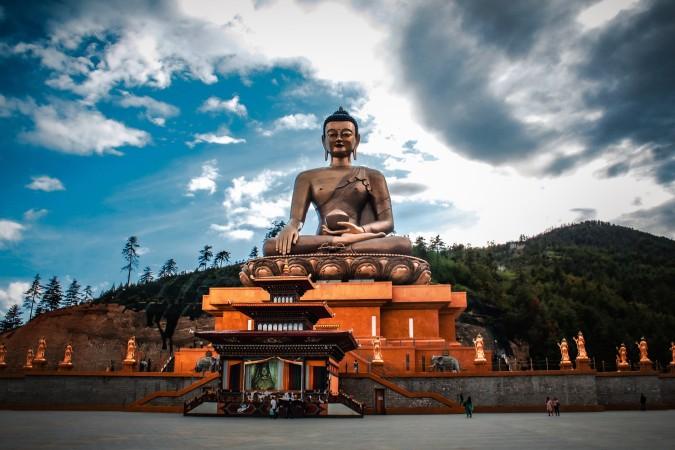
Buddha Dordenma Statue - © gather
Top Attractions in Thimphu
Thimphu, offers a blend of natural, historical, and cultural attractions that reflect the nation's rich heritage and stunning landscapes. Here are some of the top attractions in Thimphu:
Tashichho Dzong
Location: Located just outside Thimphu town, on the right side near the banks of the Wang Chhu River.
Tashichho Dzong is one of Thimphu’s most iconic landmarks, serving as both the seat of the royal government and a monastic center. This impressive fortress is especially lively during the Thimphu Tshechu festival, when it becomes the heart of colorful religious dances and ceremonies. The dzong’s striking architecture and historical significance make it a must-visit site for anyone exploring Bhutan's cultural heritage.
Buddha Dordenma Statue
Location: Perched on the outskirts of Thimphu atop a hill in Kuenselphodrang Nature Park.
Standing majestically at Kuensel Phodrang, the Buddha Dordenma Statue overlooks the Thimphu Valley, offering breathtaking panoramic views. This massive bronze statue, gilded in gold, is not only an awe-inspiring sight but also holds over 100,000 smaller Buddha statues inside, each beautifully crafted. It’s a peaceful spot for reflection and an essential stop for visitors seeking spiritual and scenic beauty in Thimphu.
Motithang Takin Preserve
Location: Situated in the Motithang district of Thimphu, approximately 15 minutes northwest of the city center.
Just a short drive from Thimphu's city center, the Motithang Takin Preserve is dedicated to Bhutan’s national animal, the takin. This rare and unique creature, found only in the Eastern Himalayas, has an unusual appearance and fascinating backstory tied to Bhutanese folklore. The preserve offers visitors a chance to see this rare animal up close while supporting Bhutan’s wildlife conservation efforts.
National Memorial Chorten
Location: Located on Doeboom Road in the heart of Thimphu Valley.
The National Memorial Chorten is one of Thimphu’s most revered religious sites, built in memory of Bhutan’s third king. It serves as a focal point for daily worship and religious practices, with locals walking around the stupa while spinning prayer wheels. The chorten’s beautiful design and spiritual importance offer visitors a deeper understanding of Bhutanese Buddhist practices.
Thimphu Folk Heritage Museum
Location: Nestled in Kawajangsa, the bustling heart of Thimphu, the capital of Bhutan.
Nestled in a traditional three-story rammed mud and timber house, the Thimphu Folk Heritage Museum takes you on a journey into Bhutanese rural life. The museum displays a variety of artifacts, tools, and household items that reflect Bhutan's cultural heritage and the way of life in rural areas. It’s a fascinating stop for anyone interested in Bhutan’s traditional customs and daily life.
Simtokha Dzong
Location: Situated along the old Paro-Phuentsholing road, around 5 kilometers south of Thimphu.
Simtokha Dzong is known as the oldest dzong in Bhutan, dating back to 1629. It serves as both a monastic and administrative center and is home to one of the country’s premier institutes for learning Dzongkha, Bhutan’s national language. Its rich history and architectural beauty make Simtokha Dzong a significant cultural and educational landmark.
Clock Tower Square
Location: Situated in the heart of Thimphu town.
Clock Tower Square is a bustling gathering spot where locals and visitors alike come to relax. The square features a beautifully designed clock tower surrounded by shops, cafes, and restaurants. Frequently hosting public events, performances, and festivals, the square adds a lively and vibrant charm to the city’s urban landscape.
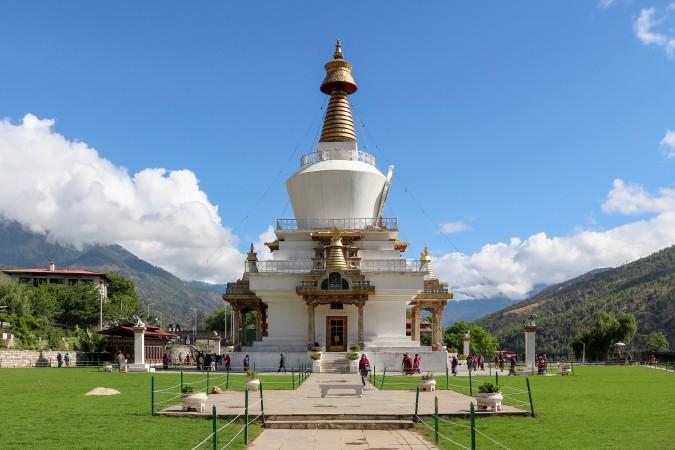
Memorial Chorten, Thimphu - © gather
Must-Try Dishes in Thimphu
When visiting Thimphu, Bhutan, to truly understand a taste of Bhutan’s rich culinary heritage and reflect the agricultural practices and cultural influences that have shaped Thimphu’s cuisine over the centuries. There are several traditional Bhutanese dishes that you must try to experience unique flavors and cooking methods of the region:
Ema Datshi
This is the national dish of Bhutan and a staple in every meal. It's a spicy stew made from local cheese and chili peppers. Ema Datshi varies in heat and flavor depending on the types of cheese and chilies used, making it a unique culinary experience in each restaurant or home.
Phaksha Paa
A hearty stew that consists of pork cooked with spicy red chilies. This dish is often accompanied by radishes or spinach, adding a comforting balance to the spiciness. Phaksha Paa represents the Bhutanese love for meaty, flavorful dishes that combat the cold mountain weather.
Momos
These are Tibetan-style dumplings that are very popular in Thimphu. Filled with either meat or vegetables, momos are steamed and served with a spicy dipping sauce. They are a common snack found throughout the city and are a must-try for their delicate wrappers and flavorful fillings.
Jasha Maru
A traditional Bhutanese chicken curry that is lightly spiced and cooked with tomatoes, garlic, and ginger. This dish is typically served with red rice and provides a less spicy alternative for those who may find other local dishes too hot.
Red Rice
This is a Bhutanese staple, grown in the Paro Valley and often served alongside various dishes. Red rice is more nutritious than white rice and has a nutty flavor, making it a favored choice in health-conscious and traditional meals alike.
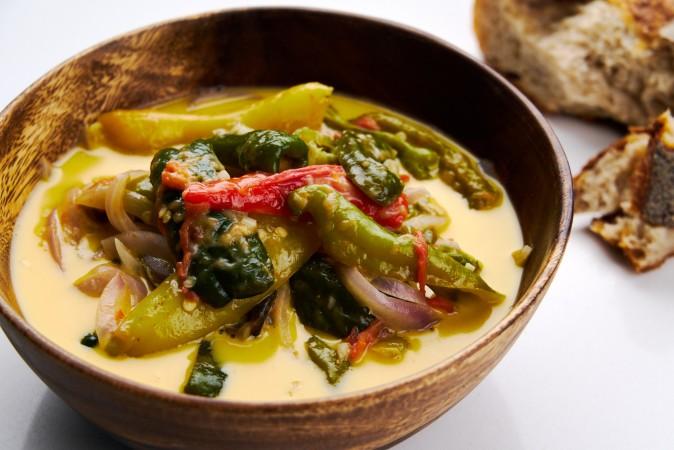
Ema Datshi - © gather
Festivals & Local Celebrations
Bhutan’s rich traditions and religious practices but also offer visitors an exceptional opportunity to see the Bhutanese way of life up close. Each event is a deep dive into the country’s ethos, making them must-see events for any cultural enthusiast visiting Thimphu.
Thimphu Tshechu
Time of Year: This festival usually takes place in September or October, depending on the lunar calendar.
Thimphu Tshechu is one of the biggest religious festivals in the country, celebrated for three days in the courtyard of the Tashichho Dzong. Visitors can expect to see live performances, including mask dances known as Cham dances, which are meant to impart moral lessons or depict the history of Bhutan. The festival is a colorful display of culture with locals donning their finest traditional attire, making it a great opportunity for photographs and cultural immersion.
Thimphu Drubchen
Time of Year: Held just before the Thimphu Tshechu, usually in late September.
Known as the precursor to the Tshechu, this festival is less known to tourists and features similar religious mask dances but on a smaller scale. The Drubchen showcases the rich ritualistic heritage of the monastic practices and provides a more intimate glimpse into Bhutanese spirituality.
National Day
Time of Year: December 17th annually.
National Day in Thimphu is celebrated to mark the coronation of the first king of Bhutan. The day is filled with cultural performances, speeches, and festivities across the city. It's a national holiday with much patriotism and joy, offering visitors a chance to experience national pride Bhutanese-style.
Dochula Druk Wangyel Festival
Time of Year: Held on December 13th each year.
This unique festival is celebrated at the Dochula Pass, a short drive from Thimphu. It commemorates Bhutanese soldiers and features a series of traditional dances and performances by the Royal Bhutan Army rather than monks. The festival also offers breathtaking views of the Himalayan range, making it a spectacular setting for cultural festivities.
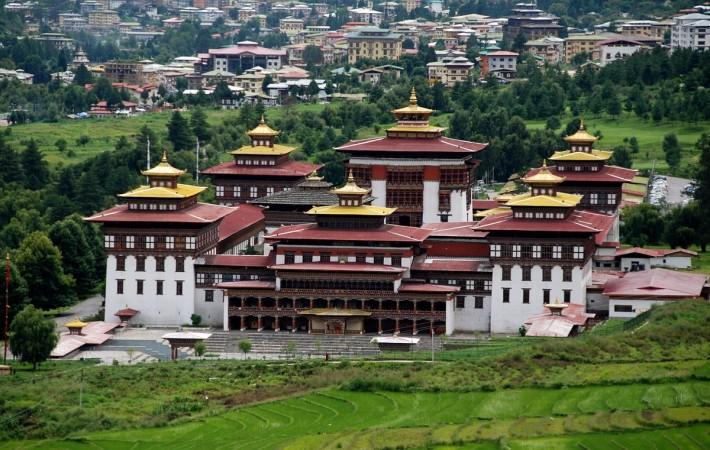
Tashichho Dzong - © gather
Weather in Thimphu: Best Time to Visit
Thimphu's weather and climate are characterized by significant seasonal variations, influenced by its location in the Himalayas and its elevation geolocation.
Average Temperatures
- Winter (December-February): The coldest months with average temperatures ranging from -2°C to 12°C (28°F to 54°F). Snowfall is common, particularly in January.
- Spring (March-May): A pleasant time with temperatures gradually warming up from 5°C to 20°C (41°F to 68°F). Rainfall begins to increase towards the end of spring.
- Summer (June-August): Marked by the monsoon season, temperatures are mild, ranging from 15°C to 25°C (59°F to 77°F), but with heavy and frequent rainfall, making it the wettest season.
- Autumn (September-November): Characterized by clear skies and mild weather with temperatures ranging from 7°C to 23°C (45°F to 73°F). Rainfall decreases, making it a popular time for tourism.
Best Time to Travel
The best time to visit Thimphu is during the spring (March to May) and autumn (September to November). These periods offer mild weather, making it ideal for exploring the outdoors and participating in festivals. The skies are generally clear, offering stunning views of the Himalayas.
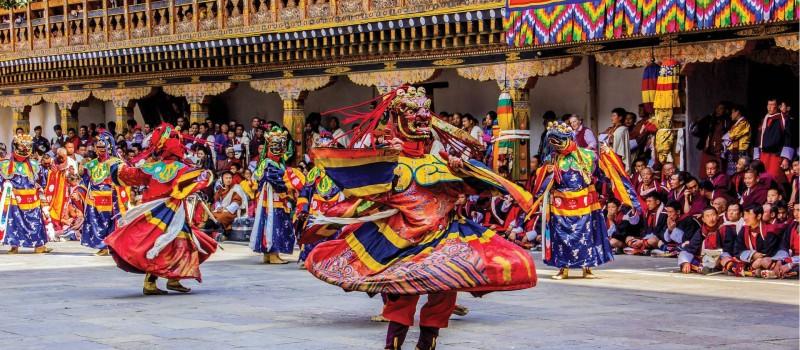
Bhutan Thimphu Tshechu Cultural Festival - © gather
Culture Etiquette in Thimphu
Visitors to Thimphu, and Bhutan more broadly, are often struck by the unique cultural etiquette that reflects the deep Buddhist traditions and the nation's focus on Gross National Happiness. Here are some important cultural customs and etiquette tips that travelers should be aware of:
Dress Code
Modesty is key in Bhutan. When visiting religious sites such as monasteries, dzongs, and temples, both men and women should wear long trousers and long-sleeved tops to cover shoulders and knees. Hats should be removed as a sign of respect when entering these sacred places.
Greeting Customs
The traditional greeting in Bhutan is to say “Kuzuzangpo” accompanied by a slight bow with the hands clasped together at the chest level. It's a respectful and friendly way to greet locals.
Respect for Royalty and Religion
The Bhutanese hold their monarchy and religious practices in high esteem. It’s important to show respect when discussing the royal family or religious matters. Photography inside temples and dzongs is often prohibited or restricted to certain areas, so it's important to look for signs or ask for permission.
Footwear
Shoes should generally be removed before entering someone's home, and often when entering temple halls or other religious buildings. This practice shows respect for the cleanliness and sanctity of the indoor environment.
Tipping and Bargaining
Tipping is not a traditional part of Bhutanese culture and is not expected, but it is appreciated for good service in hotels and restaurants. Bargaining is not common in formal stores but can be acceptable in local markets; however, it should be done respectfully and not aggressively.
Environmental Consideration
Bhutan places a strong emphasis on conservation and the environment. Visitors should be mindful of their environmental impact, adhere to local guidelines on waste disposal, and maintain decorum in natural settings.
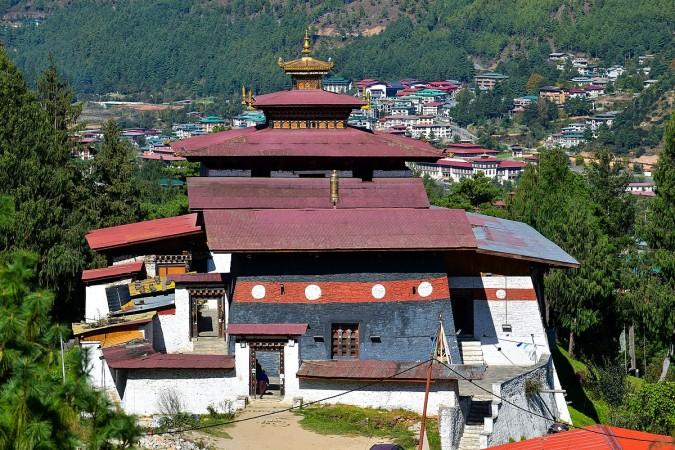
Changangkha Lhakhang - © gather
Essential Travel Information
Getting to Thimphu
By Air
- Paro International Airport: This is the only international airport in Bhutan, located about 51 kilometers (approximately 32 miles) from Thimphu. It connects Bhutan with several major cities in nearby countries, including flights from India, Nepal, Bangladesh, and Thailand.
- Airport Transfers: From Paro, visitors can reach Thimphu by taxi or by arranging a private vehicle through a tour operator, which is often included in travel packages. The drive takes about 1 to 1.5 hours, offering scenic views along the winding mountain roads.
Getting Around Thimphu
By Taxi
Taxis are readily available in Thimphu and are a convenient way to move around the city. They can be hailed on the street or booked through hotels. Fares are reasonable but should be agreed upon before departure.
By Bus
Thimphu has a local bus service that operates routes throughout the city and its outskirts. Buses are frequent and cheap, making them an economical option for getting around, especially for longer stays.
By Car Rental
Renting a car with a driver is another option for those who prefer a private and comfortable way to explore Thimphu and the surrounding areas. This can be arranged through travel agencies or some hotels.
Walking
Thimphu is also a pedestrian-friendly city, with many of its attractions located within walking distance from the city center. Walking is not only feasible but also enjoyable due to the city's clean air and scenic beauty.
ATMs
They are widely available in Thimphu, especially in central areas and near major shopping centers and tourist sites. These ATMs accept international Visa and MasterCard, although it's advisable to check with your bank for compatibility and fees before traveling.
Accommodation Choices in Thimphu
Thimphu offers a range of accommodations, from luxurious hotels to more modest guesthouses and homestays, catering to various preferences and budgets:
- Luxury Hotels: For those looking for comfort and high-end amenities, options like the Taj Tashi Thimphu and Le Méridien offer premium services with traditional Bhutanese touches.
- Mid-Range Hotels: There are numerous comfortable and reasonably priced hotels in Thimphu such as Hotel Druk and Hotel Jumolhari, which provide good facilities without breaking the bank.
- Budget Accommodations: For travelers on a tight budget, guesthouses and homestays provide affordable and authentic experiences. These are often family-run and offer a chance to experience local lifestyle.
- Eco-Lodges and Resorts: For a unique experience, there are several eco-lodges and resorts around Thimphu that focus on sustainability and eco-friendly practices, providing serene views of the natural landscape.
Articles for you

Explore Yala National Park - Sri Lanka Travel, Asia
Tucked away in Sri Lanka’s southeastern corner, Yala National Park is where wild nature meets deep tradition. Known worldwide for its leopard population, the park is also home to elephants, sloth bears, crocodiles, and hundreds of bird species. Beyond wildlife, Yala opens doors to a cultural landscape dotted with ancient temples, Buddhist ruins, and coastal villages. For travelers seeking more than just a safari, Yala offers a chance to explore eco-tourism, local communities, and sacred heritage sites.
Population: The Yala National Park area doesn’t have a human population.
Economy: The economy around Yala National Park thrives on a blend of eco-tourism, agriculture, and local services. Safari tours, eco-lodges, and cultural experiences drive steady income for nearby towns like Tissamaharama and Kataragama, supporting thousands of families.
Landmarks: Famous for Block I of Yala and wildlife encounters, including elephants, sloth bears, crocodiles, and exotic bird species.

Explore Galle - Sri Lanka Travel, Asia
Nestled on Sri Lanka’s southern coastline, Galle is a vibrant city where history meets the sea. Its cobbled streets, colonial architecture, and serene beaches make it a must-visit destination for travelers seeking a blend of culture, adventure, and relaxation. A UNESCO World Heritage site, Galle captivates visitors with its Dutch Fort, bustling markets, and friendly locals. Whether you’re exploring the ramparts at sunset or savoring fresh seafood by the shore, Galle promises an unforgettable journey into Sri Lanka’s heritage.
Population: Approximately 113,000 in 2023.
Economy: Galle’s economy thrives on tourism, trade, and fisheries. The city’s historic fort, colonial architecture, and coastal charm draw thousands of international visitors each year, making tourism its main economic driver. Fishing remains vital for local livelihoods, supplying fresh seafood across the region.
Landmarks: Famous for the Galle Fort, Dutch Reformed Church & Maritime Museum, and Unawatuna Beach.

Explore Bentota - Sri Lanka Travel, Asia
Nestled along Sri Lanka’s southwestern coast, Bentota is a tropical paradise that blends golden beaches, vibrant culture, and thrilling adventures. Famous for its calm waters, luxury resorts, and scenic river estuary, Bentota has become a top destination for travelers seeking both relaxation and authentic experiences. From serene beach walks at sunrise to adrenaline-pumping water sports, this coastal town offers a perfect balance of leisure and exploration. With its proximity to Colombo and Galle, Bentota is easy to reach, making it an ideal stop for both short escapes and extended holidays.
Population: Approximately 37,000 in 2023.
Economy: Bentota’s economy thrives mainly on tourism, which drives local businesses such as hotels, restaurants, and wellness retreats. The town also benefits from fishing, coconut cultivation, and handicrafts like wood carving and batik textiles. Many residents rely on the growing demand for water sports and Ayurvedic treatments, making tourism the backbone of both income and employment in the area.
Landmarks: Famous for Bentota Beach, Bentota River Safari, and Kande Vihara Temple.

Explore Mirissa - Sri Lanka Travel, Asia
Mirissa is a charming coastal town on Sri Lanka’s southern shoreline. Known for its golden beaches, turquoise waters, and vibrant marine life, it has become a must-visit stop for travelers exploring the island. Many come for whale watching, surfing, and sunset views at Coconut Tree Hill, but Mirissa offers much more than postcard beauty. The fishing boats you see anchored by the bay carry generations of stories. Local traditions, delicious cuisine, and a laid-back rhythm of life shape every visitor’s experience.
Population: Approximately 4,700 in 2023.
Economy: Mirissa’s economy is largely shaped by its coastal location. Fishing has long been the backbone of local livelihoods, with generations relying on the Indian Ocean for income. In recent decades, tourism has become the main driver of growth, thanks to whale watching, surfing, and beachside hospitality.
Landmarks: Famous for Mirissa Beach, Coconut Tree Hill, and Parrot Rock Bridge.

Explore Nuwara Eliya - Sri Lanka Travel, Asia
Tucked away in the Central Highlands of Sri Lanka, Nuwara Eliya is often called “Little England”. With its rolling tea plantations, cool misty mornings, and colonial charm, this mountain town feels like a step into another world. Travelers come here to breathe fresh air, walk through flower gardens, sip the finest Ceylon Tea, and enjoy a pace of life far from the island’s busy cities. Whether you’re drawn by scenic landscapes, heritage architecture, or the warmth of its people, Nuwara Eliya is a destination that blends nature, culture, and history in perfect harmony.
Population: Approximately 781,000 in 2023.
Economy: Nuwara Eliya’s economy thrives mainly on tea production, as it sits in the heart of Sri Lanka’s central highlands, famous worldwide for Ceylon Tea. The city also benefits from a growing tourism industry, attracting visitors with its colonial charm, cool climate, and scenic landscapes.
Landmarks: Famous for Gregory Lake, Hakgala Botanical Garden, and Victoria Park.

Explore Sukau - Malaysia Travel, Asia
Nestled on the banks of the Kinabatangan River in Sabah, Malaysian Borneo, Sukau is a destination where wildlife, culture, and conservation come together. Known as one of Asia’s top spots for river safaris and eco-tourism, this quiet village offers a front-row seat to encounters with Bornean orangutans, pygmy elephants, proboscis monkeys, and exotic birdlife.
Population: Approximately 1,400 in 2019.
Economy: Sukau’s economy is shaped by its riverine location and natural resources. Traditionally, the Orang Sungai community relied on fishing, small-scale farming, and forest gathering for their livelihood. Today, the village has shifted toward eco-tourism, with river cruises, jungle trekking, and homestays providing income.
Landmarks: Famous for the Kinabatangan River cruises, Gomantong Caves, and Ox-bow lakes and wetlands.
